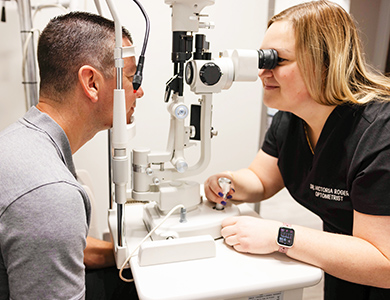
43.8% of Americans over the age of 65 have claimed they do not need to go to an optometrist for regular eye care. But this is in direct competition with the proven one in three people who develop an age-related eye disease by that same age. The most commonly developed diseases are glaucoma, macular degeneration, diabetic retinopathy, and cataracts. All of which will need diagnosis and treatment by an optometrist to properly manage.
How often should you have eye exams?
Adults aged 18 to 60 should have eye exams every two years, if not more frequently. Adults above the age of 60 should increase the frequency of their eye exams to once each year if they haven’t already. Children should have their eyes examined starting at six months and continuing every two years until they turn eighteen. If your child is at risk or displays vision problems early on they will need more frequent eye exams. If you have risk factors for poor vision and eye health, schedule more regular eye exams to have an optometrist monitor your eyes. This can help to treat eye diseases and vision problems before they take your sight. Risk factors include:
- History of eye disease
- Diabetes
- High blood pressure
- Visually demanding job
- Prescription drugs with side effects known to hurt vision
- Previous eye surgery
- Previous eye injuries
Reason 1:
Glaucoma can only be detected through eye exams
Regular eye exams are the best ways to identify glaucoma in its early stages. Optometrists look at your vision and medical histories to pinpoint any concerning signs you could be susceptible to glaucoma. Following this your optometrist will take you through two tests:
- Visual Acuity Testing
- Basic Visual Field Testing
They’ll often follow-up with an eye pressure test which can quickly reveal signs of potential glaucoma development. As glaucoma can show no noticeable symptoms and can eventually steal your sight, it’s important to have a professional regularly check to catch any development of disease before it progresses.
Reason 2:
Serious illnesses and diseases unrelated to eyes can be identified
Something as ‘simple’ as blurred vision can actually be an indicator that much larger health problems are in the works. Eye exams can unveil:
- Certain cancers
- Rheumatoid arthritis
- Diabetes
- Hypertension
- High cholesterol
By not putting off your eye exam you’re increasing the likelihood of catching a harmless medical condition while it’s still manageable.
Reason 3:
Digital eye strain could be causing sneaky damage to your eyes
Digital Eye Strain, otherwise known as computer vision syndrome, is caused by our time spent on digital devices putting our eyes through the same motions again and again. It’s a lot like carpal tunnel. 65% of Americans have reported regularly experiencing the symptoms that go along with Digital Eye Strain. By carving out time to see your optometrist instead of putting it off for yet another month, you’ll be able to take action against progressing eye problems related to increased screen time. Optometrists can offer lens options of lifestyle adjustments that will help you better manage your eye strain.
Reason 4:
Using old prescriptions can cause eye strain and headaches
With yearly eye exams, patients are able to get prescriptions that are up-to-date. Having an eye prescription suited to your eyes now and not your eyes a year ago means fewer headaches and reduced eye strain.
While damaging your eyes with an old prescription is a myth, it doesn’t mean you should go out of your way to wear old glasses. This can lead to dizzying sensations and migraines.
Reason 5:
20/20 one year doesn’t mean 20/20 every year
Your eyesight will change over time, and not normally for the better. But going without needed glasses or contacts is worse for your eyes than going with an old prescription. By going to the optometrist regularly and not skipping out on upcoming appointments, you’re able to keep your sight in check. Ensure your eyes haven’t changed, requiring a prescription, to avoid headaches and eye strain.
Reason 6:
Catch symptomless eye diseases before it takes your sight
Like glaucoma, there are plenty of symptomless eye diseases than can sneak up on you if you’re not seen regularly by an optometrist. An eye exam can catch dry eyes, macular degeneration, diabetic retinopathy, and cataracts.
While not all will completely take your vision, many will introduce issues into everyday life. But by catching these conditions early you and your optometrist can find a treatment path that works for you. If these conditions go untreated, however, you are in for side effects such as sensitivity to light, faded colors in vision, deteriorating vision, and distorted vision among other things.
What are your options if you don’t have insurance?
If you don’t have insurance you may feel like affordable eye exams aren’t an option. But there are options for free or low-cost treatment designed with those without insurance in mind. Vision discount programs and many optometrist offices are happy to work with patients without insurance to ensure they are getting the treatment and prescriptions they need.
Are you struggling with your vision?
Contact us to schedule an appointment for your child





